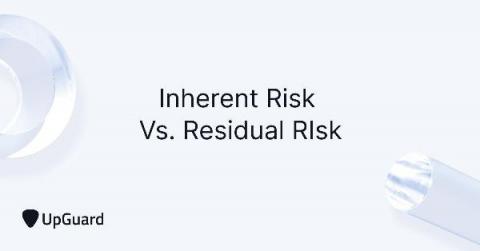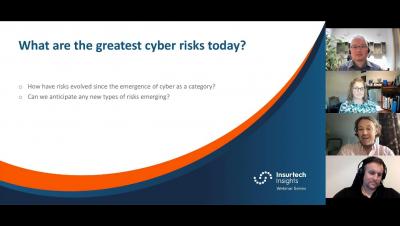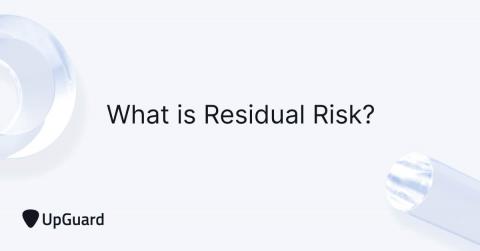Security | Threat Detection | Cyberattacks | DevSecOps | Compliance
May 2021
What is Cybersecurity Risk Management?
Every time you log on to the Internet, you put your IT systems and the data you handle at risk. At the same time, it’s also impossible to run a successful business without going online, so a key element of modern business management is a strong cybersecurity risk management program. Why? Because the only people in the cybersecurity field working harder than software engineers are the criminals trying to find a new way to breach the latest network security measures.
What Are the HIPAA Standard Transactions?
The Department of Health and Human Services (HHS) defines a transaction as an electronic exchange of information between two parties, to carry out financial or administrative activities related to healthcare. For example, a health care provider will send a claim to a health plan to request payment for medical services.
Inherent Risk vs. Residual Risk (Quick Explanation)
Inherent risks include all risks that are present without any security controls. Residual risks are the risks that remain after security controls are implemented. Residual risks are inevitable. Even with an abundance of security controls, vestiges of residual risks will remain that could expose your sensitive data to cyber attacks.This is because the proliferation of digital transformation expands the digital landscape, creating more attack vectors.
What Is NIST?
NIST is the abbreviated name of the National Institute of Standards and Technology. It’s one of many federal agencies under the U.S. Department of Commerce, and is one of the oldest physical science laboratories in the United States. As a non-regulatory government agency, NIST was originally founded to enable greater industrial competitiveness in the United States. Its focus stems from the mantra, “One cannot manage what is not measured.
Cyber Insurance: Insuring the Intangible
What is Residual Risk? Why it Matters So Much in 2021
Residual risk is the threat or vulnerability that remains after all risk treatment and remediation efforts have been implemented. Even with an astute vulnerability sanitation program, there will always be vestiges of risks that remain, these are residual risks. Because they will always be present, the process of managing residual risk involves setting an acceptable threshold and then implementing programs and solutions to mitigate all risks below that threshold.
What are the PCI DSS Password Requirements?
The PCI DSS compliance password requirements are mandated by Requirement 8 of the Payment Card Industry Data Security Standard (PCI DSS). Password compliance plays a key role in the PCI standards because it dictates the password complexity necessary to help an organization better defend its systems against unauthorized access.
What is data loss prevention?
DLP security strategies, benefits explained The threat landscape is a constantly evolving challenge for enterprise security professionals – the number of cyberattacks is continuing to rise, data exfiltration is now included in 70% of ransomware attacks, and insiders are responsible for 30% of all data breaches. As a result, enterprises are constantly looking for ways to reduce the risk of sensitive data being leaked outside the company.
Reciprocity and ZenGRC Win Four Cyber Defense Magazine InfoSec Awards
SAN FRANCISCO – May 18, 2021 – Reciprocity, a leader in information security risk and compliance with its ZenGRC platform, today announced ZenGRC has been awarded four coveted Cyber Defense Magazine (CDM) InfoSec Awards: Most Innovative in IT Vendor Risk Management, Cutting Edge in Risk Management, Most Innovative in Third Party Risk Management, and Publisher’s Choice in Compliance.
What's new in the 2021 'Open Source Security and Risk Analysis' report
As the use of open source has grown, so has the number of vulnerabilities. Uncover the latest findings from the 2021 OSSRA report. Open source libraries are the foundation for every application in every industry. But paralleling the popularity of open source is a growth in risk—specifically around open source licensing, security, code quality, and especially open source sustainability.
What is FedRAMP?
The Federal Risk and Authorization Management Program, or FedRAMP, is a federal government program to provide a standardized approach for security assessment, authorization, and continuous monitoring for cloud services and cloud products offered by cloud service providers (CSPs). FedRAMP creates a single risk-based standard so government agencies can engage with cloud-based providers more easily.
What is inherent risk? Your sensitive data could be In danger
Inherent risks are the cyber risks and vulnerabilities within an organization before security measures are implemented. In contrast, residual risk is calculated after cybersecurity protections have been put in place to protect against all of these inherent risks; its calculation includes every possible attack vector that could affect a system or data.
Why SOX Compliance is Required
The Sarbanes-Oxley Act is a federal law that applies to all publicly traded businesses in the United States. It imposes sweeping corporate governance standards on those businesses, to improve accountability in the boardroom and senior management ranks and to make corporate financial statements more reliable.
Reciprocity Experiences Record-Breaking Results in First Quarter 2021
SAN FRANCISCO – May 4, 2021 First Quarter 2021 Highlights Reciprocity, a leader in information security risk and compliance with its ZenGRC platform, today announced the company saw outstanding results in the first quarter of 2021, achieving new records across its go-to-market initiatives, coming off an unprecedented 2020. Last year the management of risk and compliance became a strategic imperative and top board-level concern.










